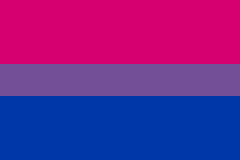Bisexual pride flag
.jpg)

| LGBT symbols | ||||||||
|---|---|---|---|---|---|---|---|---|
|
|
||||||||
The bisexual pride flag was designed by Michael Page in 1998 in order to give the bisexual community its own symbol comparable to the gay pride flag of the larger LGBT community. His aim was to increase the visibility of bisexuals, both among society as a whole and within the LGBT community. The first bisexual pride flag was unveiled at the BiCafe's first anniversary party[1] on December 5, 1998[2] after Page was inspired by his work with BiNet USA.[3]
Design and colors

Page took the colors from an existing bisexual symbol and gave it his own spin, saying,
| “ | In designing the Bi Pride Flag, I selected the colors and overlap pattern of the 'bi angles' symbol.[4] | ” |
(Biangles, or bisexuality triangles, are another symbol for the bisexual community. While the origin of this symbol is ambiguous, theories suggest the colors may represent hetero-, homo-, and bisexuality, or attraction to men, women, and both men and women. The crescent moon symbol is another reference to bisexuality and is rooted in the Nazi movement’s pink triangle designated to homosexuals.) [3][5]
Page describes the meaning of the pink, lavender, and blue (ratio 2:1:2) flag [1] as this: "The pink color represents sexual attraction to the same sex only (gay and lesbian), The blue represents sexual attraction to the opposite sex only (straight) and the resultant overlap color purple represents sexual attraction to both sexes (bi)."[4][6]
Page describes the flag’s meaning in deeper terms, stating "The key to understanding the symbolism of the bi pride flag is to know that the purple pixels of color blend unnoticeably into both the pink and blue, just as in the 'real world,' where bi people blend unnoticeably into both the gay/lesbian and straight communities" [3]
The flag's aspect ratio is not fixed but 2:3 and 3:5 are often used, in common with many other flags.
The stripe colors and widths, from top to bottom, are pink (40%), purple (20%), and blue (40%).[4] The exact colors given by the designer are: PMS 226, 258, and 286.[1] Their approximate HTML values are #D60270, #9B4F96, #0038A8;[7] their approximate RGB values are (214,2,112), (155,79,150), and (0,56,168), respectively.[8]
It is not patented, trademarked, or service marked.[4]
See also
References
- 1 2 3 Young, Randy (6 June 2015). "BiPride Flag". Flagspot. Flags of the World. Retrieved October 24, 2015.
- ↑ http://www.wright.edu/counseling/SafezoneSymbols.html
- 1 2 3 Petronzio, Matt (13 June 2014). "A Storied Glossary of Iconic LGBT Flags and Symbols". Mashable. Mashable, Inc. Retrieved October 24, 2015.
- 1 2 3 4 "History, Bi Activism, Free Graphics". BiFlag.com. 1998-12-05. Archived from the original on 2012-02-04. Retrieved 2012-01-23.
- ↑ "Pride Symbols and Icons". Association for Lesbian, Gay, Bisexual, and Transgender Issues in Counseling of Alabama. ALGBTICAL. Retrieved October 24, 2015.
- ↑ Rosiek, Jerry (2005). "Rainbow Flag and Other Pride Symbols". In Sears, James Thomas. Youth, Education, and Sexualities: An International Encyclopedia. 2. Westport, Conn.: Greenwood. p. 701. ISBN 0-313-32755-6.
- ↑ Pantone color conversion chart at goffgrafix.com
- ↑ HEX to RBG Conversion Tool at Colorrrs.com